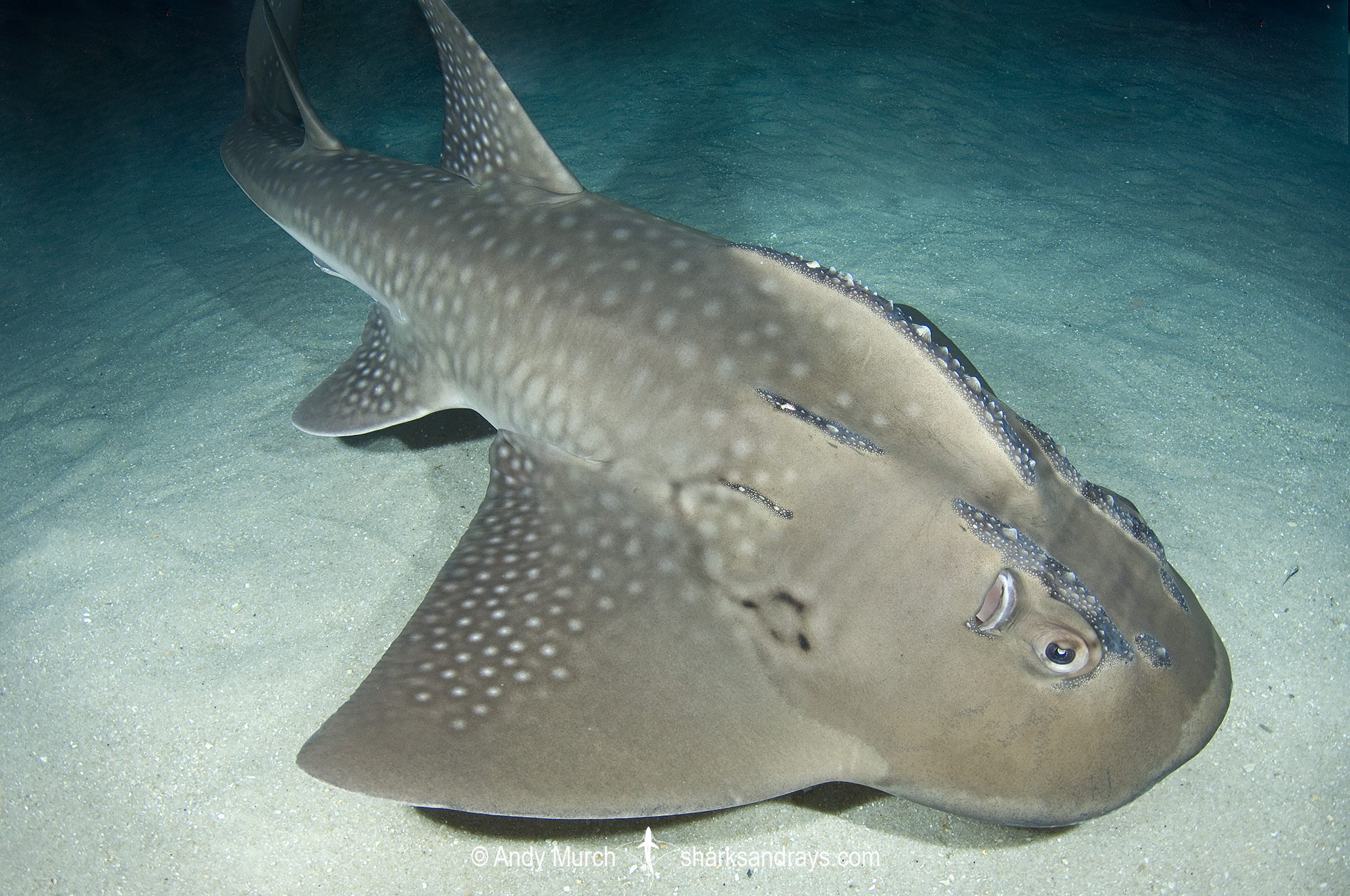Common name(s)
Bowmouth Guitarfish, Shark Ray.
Identification
A large, heavy-bodied ray with a shark-like body and a broadly rounded head and snout that is well separated from the pectoral fins. Eyes large. Spiracle skin-folds absent. Pronounced ridges topped by very large, broad-based thorns above eyes and spiracles, along median from nape to level of pectoral insertion, and two short rows on each shoulder. Skin evenly covered in very small denticles. Dorsal fins very tall and weakly falcate. First dorsal fin origin slightly anterior to pelvic fin origins. Pectoral fins wide, anterior margins weakly convex, posterior margins straight, apices angular or narrowly rounded. Caudal fin large and lunate, with a defined lower lobe. Well developed lateral keel at caudal base.
Colour
Dorsum bluish-grey to brown. Dorsum and fins posterior of mid pectoral level, densely covered with dark-edged, pale spots. Spotting more distinct towards posterior margins of fins. Juveniles have white-edged, black, V-shaped marking above pectoral fins. Thin, dusky, transverse bands sometimes present between eyes. Markings less distinct with age. Ventrum pale.
Size
Maximum length 270cm. Size at birth 46-48cm.
Habitat
Tropical/ subtropical seas. Demersal on inshore and offshore sand and mud flats, and on coral reefs. To at least 70m.
Distribution
Ind0-West Pacific. Widespread but depleted along most coastlines from South Africa north to the Red Sea and Arabian Gulf, east India and Southeast Asia, to southern Japan and northern Australia.
Conservation Status
CRITICALLY ENDANGERED
The ‘white’ fins of shark-like rays (including sawfishes, wedgefishes, and giant guitarfishes) are considered the best quality fins for human consumption and are among the highest valued in the international shark fin trade. The meat is of high quality and generally consumed locally. There is a high level of fisheries resource use and increasing fishing pressure across the range of the Bowmouth Guitarfish, and as a result, targeted and incidental fishing effort is placing significant pressure on all wedgefish species in the Indo-West Pacific. Where wedgefishes and giant guitarfishes have been targeted or exploited as incidental catch, severe declines, population depletions, and localized disappearances have occurred. Severe population reduction in the Bowmouth Guitarfish is inferred from actual levels of exploitation, as well as several historical accounts and contemporary datasets from Iran, Pakistan, India, Thailand, and Indonesia. While some parts of Australasia provide refuge from intense fishing effort, this proportion of the species’ range is not considered to be large enough relative to the global range to lower the assessment. It is inferred that the Bowmouth Guitarfish has undergone a >80% population reduction over the last three generations (45 years) and it is assessed as Critically Endangered A2bd.
Citation
Kyne, P.M., Rigby, C.L., Dharmadi & Jabado, R.W. 2019. Rhina ancylostoma. The IUCN Red List of Threatened Species 2019: e.T41848A124421912. https://dx.doi.org/10.2305/IUCN.UK.2019-2.RLTS.T41848A124421912.en. Downloaded on 09 May 2021.
Reproduction
Aplacental viviparous. Litter size 2-11.
Diet
Feeds on demersal fishes, crabs and shrimp, bivalves, and cephalopods.
Behavior
Poorly known.
Reaction to divers
Generally moves away if approached.
Diving logistics
Although bowmouth guitarfishes are quite rare in most parts of their range, random encounters in southern Queensland, Australia are not that uncommon. Spots where they have been seen include the Yongala Wreck, Wolf Rock, and even Julian Rocks in N.S.W.
What’s new
View our full list of updates
Similar species
False Shark Ray Distinguishable by much narrower head and geographic range; confined to West Africa.




